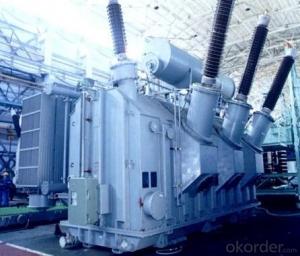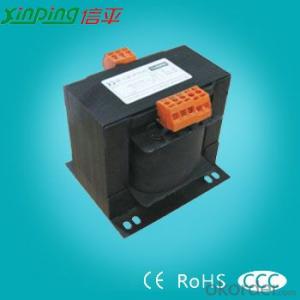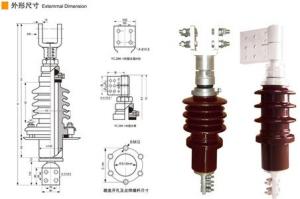31.5MVA/220kV single phase traction transformer
- Loading Port:
- Tianjin
- Payment Terms:
- TT OR LC
- Min Order Qty:
- 1 pc
- Supply Capability:
- 1 pc/month
OKorder Service Pledge
OKorder Financial Service
You Might Also Like
Quick Details
| Place of Origin: | HeBei | Brand Name: | CNBM | Model Number: |
|
| Usage: | Power | Phase: | Three | Coil Structure: | Toroidal |
| Coil Number: | 3 Winding | Capacity: | Rated Voltage: | 31.5MVA/220kV | |
| Connection Symbol: | YNd11 Dyn11 YNyn0d11 | Tank: | Cover type or Bell type | OLTC: | MR or ABB or SMS |
Packaging & Delivery
| Packaging Detail: | Mainbody --naked Disassembled parts -- crate |
| Delivery Detail: | 3 months |
Specifications
1. CESI certificate
2. High short-circuit withstand
3. Low loss, PD and noise
4. CTQC certificate
5. No leakage
Description
The application of the 31.5MVA/220kV single phase traction transformer, and matches well with the transmission capacity of UHV lines, which has wide prospect of application. Because of its large capacity and large volume, the whole transportation weight with nitrogen is about 470-490 tons, and due to the restricted transport conditions, the transportation becomes the critical issue for application of the 31.5MVA/220kV single phase traction transformer. In order to make the products applicable to any UHV substation in our country, the state grid of corporation of China set the "A study of easy-transport large capacity UHV Transformer” as a key scientific research projects, and entrusted BTW to carry out the research.
During the process of research and development, BTW adopted the advanced design technology and modular design, the transformer can be transported disassembly and with advantages of compact core and winding body, less transportation weight and low transportation cost, effectively solves the need of UHV construction in the transportation restricted areas. By using the most advanced 3D magnetic field calculation software, BTW performed detailed analysis and calculation for the magnetic flux leakage and eddy current loss of the transformer coil, iron core and oil tank steel structures. Besides, by using of the advanced electric field calculation software, BTW performed detailed analysis and calculation of main longitudinal insulation, and mastered the arrangement of the main longitudinal insulation of large capacity UHV transformer and the control of distribution of winding magnetic flux leakage. All of which make the products with low loss, low noise, small volume, strong anti short circuit ability, no local overheating and other significant advantages, and guarantee the long-term safe and stable operation.
The world's first on-site assembled large capacity UHV Transformer’s right at the first time once again filled the gap in the field of UHV transformer research after Chinese transformer industry overcame the difficulty of integral transport of the 31.5MVA/220kV single phase traction transformer, which marks BTW has fully occupied the world transformer industry technical peak. The successful development of the product filled the gaps in the domestic technology and met the urgent need of UHV construction application in our country, greatly improved the technical level and manufacturing ability of BTW in terms of UHV Transformer products.
- Q: I have a US microscope (110v) with a built-in transformer using a 6v, 10w lamp. I want to use this with a 220 v supply. What are the specifications for the cheapest (external) transformer I can use for this purpose?
- What do you accomplish by converting a 110v appliance to a 220v appliance.
- Q: A CD player uses two 1.5 v batteries. If you want to plug it into a 120 v outlet, what kind of transformer will you need (Step up or Step down)? What must be the ratio of the number of turns in the primary to the number of turns in the secondary?
- Do nopt worry about transformer.just buy a charger for the CD player, it's much more than a transformer and is necessary and sufficient.
- Q: I have to build a transformer which are the main formulas or some source that explains this
- You need to specify what the transformer is to be used for. (why do you have to build a transformer ?) (the characteristics of the core are critical to the design) Until you specify that, only the simplest of basics relating to turns ratios can be stated: 1 - Power in primary Power in secondary 2 - Voltage ratio turns ratio 3 - Current ratio 1 / (turns ratio) [from #1 #2] 4 - Impedance ratio Turns ratio squared. [ from #2 #3] **IF** it is a power transformer, I suggest getting a transformer with the same, or slightly higher POWER rating, then simply re-wind the secondary using #2 above. (I did) or Google: how to design transformer windings then pick the one that suits your needs best.
- Q: I live in Market Weighton and I need to know why my local electricity transformer is. Where will I need to look?
- For residential, the step down transformer for home electricity use is typically a pole top mounted transformer. It may be at the top of a power pole near your residence. Sometimes there may be a pad mount transformer (square metal box) near your home that is used. You may want to look outside your home, and see where the wires coming into your electrical service are coming from. That should tell you where the transformer is. If you live in a newer neighborhood, you may have underground service ( thus no power poles) and the transformer may not be visible. It would likely be close by in an underground electrical vault. There is a picture of a pole top transformer in the attached article below:
- Q: Can anyone explain what each wire does in this spicific microwave transformer
- I believe the two tabs on the lower part of the transformer on your first photo, is where the mains voltage is applied ( 120 or 240 volts AC depending on country used ). If you use an ohmmeter and measure for resistance, there should be a low resistance between the two tabs, and infinite resistance to the other wires and infinite resistance to the frame of the transformer. On the second photo: The two wires will have a high voltage AC output on them when measured from either wire to the frame of the transformer. One end of the high voltage winding is attached to the frame of the transformer as a ground return. You can see the attachment near the top of the transformer. There is also a voltage superimposed between the two wires on the second photo. This is used to heat the filament of the magnetron tube. If you measure the resistance between the two wires you should get a very low resistance. If you measure from one wire and the frame of the transformer, you should get a higher (but not infinite) resistance.
- Q: i need a 120VAC to 160VAC step-up transformer; like, not an already built converter, but a just bulk single transformer. where can i buy one?and don't say go look in OKorder, coz i've already looked and there isn't any
- The dimensions of a transformer depend on the required current rating. In some circumstances, you could even use a transformer with a multi- tapped primary. By tapping it lower, you may find 160V between the neutral or common tap and a tap higher up the winding. It would be working as an autotransformer, which is not a particularly good form. I would question for what purpose you would need 160V., anyway? It seems a strange voltage to need.?
- Q: anyone have any pictures ideas on how to do a transformers cake???? i need one for this sunday any help would be appreciated
- Transformers (cake) more than meets the eye! Go to the movie website. I think you will have better luck having a bakery do this for you.
- Q: Single-phase and three-phase transformer is what it means
- Input and output are single-phase AC is the single-phase transformer. Input and output are three-phase symmetrical AC is the three-phase transformer.
- Q: I am throwing my sons 7th birthday party, and again this year it is Transformers. He is asking to have some unique foods as oppose to traditional party pizza. We, of course will still have a cake but I am drawing blanks to food ideas. Does anyone have any suggestions? Thanks in advance!!
- Here's a really easy nacho dip that tastes awesome! 1 package Velveeta mexican chese (you can do spicy or mild) 1 can Hormel chili +/- green onions Melt it in an oven-safe bowl in the Microwave or oven (for however long it takes to be all melted) stirring occasionally, and eat it with tortilla chips. It's awesome!!
- Q: A step-up transformer is connected to a generator that is delivering 131 V and 96 A. The ratio of the turns on the secondary to the turns on the primary is 859 to 1. What voltage is across the secondary? An-swer in units of kV.What current flows in the secondary? Answer in units of mA.
- a step up transformer is connected to the generator. therefore the voltage on the primary side of the transformer is 131 volts. secondary turns/primary turns secondary voltage/primary voltage. therefore voltage on secondary side 131*859 112.529KV secondary turns/primary turns primary current/secondary current therefore current on the secondary side 96/859 111.756mA. in order to cross verify, the power on primary side power on the secondary side. i.e 131*96112.529KV*111.756mA.
Send your message to us
31.5MVA/220kV single phase traction transformer
- Loading Port:
- Tianjin
- Payment Terms:
- TT OR LC
- Min Order Qty:
- 1 pc
- Supply Capability:
- 1 pc/month
OKorder Service Pledge
OKorder Financial Service
Similar products
Hot products
Hot Searches
Related keywords
























